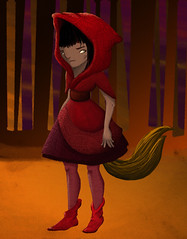The fairy tale "little red cap" is probably the most common little red riding hood story, of the wolf eating both the grandmother and the girl, who are then both saved by the heroic wood cutter. The Grim brothers were writing in the 19th century, and the story reflects the values of good moral behaviour, and the male dominated society of the time. The story gives insight into the sinful behaviour of women and the consequences for those actions, this text also illustrates the patriarchal values that were the standard of the time through the introduction of the male hero.
Though our protagonist starts out as a sweet innocent girl the introduction of the red hood illustrates from the beginning that she will stray from the path. In western society red is a colour symbolic of sin, blood, lust, anger and passion and it is through this symbolism that we accept the subtle sexualisation as it develops. This version of the story shows little red as a beautiful, slightly unintelligent, and possibly quite vain, a great deviation from the intelligent, strong willed girl in the original story. Little red is now seen purely a victim, a place appropriate for a female in the 19th century.
The sexual behaviour of little red riding hood is introduced when she talks about ‘what big’ ears, eyes and teeth the wolf has. The wolf is seen as a seducer, leading well behaved girls to sin and their death. But how is it that red riding hood doesn’t notice the change in her grandmother? It may be interpreted that red riding hood is willing to go to the wolf to be seduced. Being eaten is often a metaphor for sex or seduction, the violence and violation of being consumed by another being both frightens and arouses us; it touches the parts of our minds that have been repressed because it is seen as repulsive and sinful. This sexualisation of a young girl and an ‘evil’ creature together is the antithesis of the morals of the 19th century, and the “death” of little red riding hood is seen as a just punishment for her sins.
The Grim’s brother’s were the first to introduce a male hero to the tale, enforcing the belief that a woman will always be ‘saved’ when she finds a good man. The huntsman may be symbolic for either the father or husband figures in a woman’s life. He is wise and courageous, killing the wolf without harming the women inside it. This shows the power men had in the 19thcentury, women were the virgin/mother figure or they were eaten by the ‘wolves’.The idea of the wolf’s belly being sliced open could also be seen as a symbol for the‘re-birth’ of red riding hood, from a sinner to an innocent.
The grim’s brothers tale ‘Little red cap’ re-shaped the original grandmothers tale to reflect values and beliefs of the 19thcentury. The values portrayed in the developed version of the story and the meaning the author(s) wish to convey demonstrates that texts are shaped by and for the world, intentionally or otherwise.








